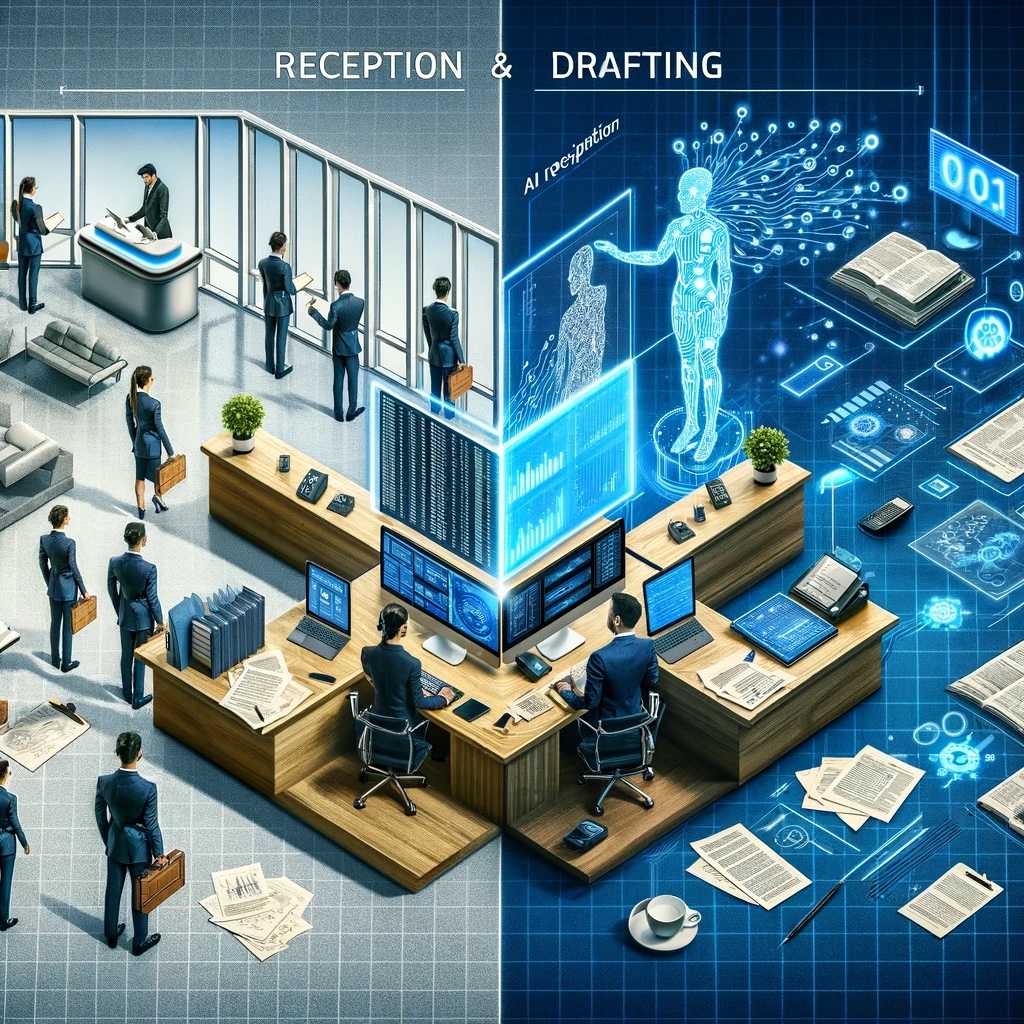Introduction
Imagine a world where your professional practice operates like a well-oiled machine, 24/7, without the constraints of human limitations. This isn’t a glimpse into a distant, utopian future; it’s a reality that AI (Artificial Intelligence) is bringing to our doorstep today.
Could AI be the game-changer in your professional practice? Imagine the possibilities!
This question isn’t just rhetorical anymore. It’s a clarion call to attorneys, doctors, accountants, and all professionals who have long relied on traditional methods. The landscape of professional services is undergoing a seismic shift, and AI stands at the forefront of this revolution.
The concept of AI as a mere technological marvel has evolved. Today, it’s not about robots taking over jobs; it’s about AI augmenting the capabilities of professionals, enhancing their services, and providing a competitive edge that was previously unimaginable. For attorneys, imagine an AI assistant that never sleeps, meticulously sorts through case files and accurately predicts legal outcomes. Doctors envisage an AI system that assists in diagnosing complex cases, offering insights drawn from a vast database of medical knowledge.
But let’s talk practicality – the real nuts and bolts of AI in professional services. Take, for instance, the traditional reception desk, often the first point of client interaction. It’s constrained by human factors – working hours, staff availability, and the inevitable human error. AI revolutionizes this through innovations like text bots and voice bots. A text bot can interact with leads and clients, scheduling appointments, answering queries, and even following up on potential leads – all in real-time and without human intervention. Imagine a voice bot that handles incoming calls, directs clients to the appropriate services, and provides information – all with the warmth and etiquette of a skilled receptionist, but with the efficiency and accuracy of AI.

The missed opportunities in not leveraging AI are stark. Every unanswered call, every unaddressed client query, and every delayed response is a potential loss – of revenue, client trust, and business growth. In the fast-paced world of professional services, where time is often the most valuable currency, AI provides a solution to capture every opportunity.
A legal firm could engage more clients by automating initial consultations through AI, ensuring that no potential client falls through the cracks. A medical practice could use AI to manage patient appointments and follow-ups, allowing doctors to focus more on patient care rather than administrative tasks.
In a survey conducted among professional service providers, over 70% acknowledged missing out on potential leads due to inadequate follow-up processes – a gap perfectly filled by AI’s 24/7 operational capability. Another study highlighted that businesses using AI for customer engagement saw a 40% increase in client satisfaction. These aren’t just numbers; they’re a testament to AI’s transformative power in professional services.
As we stand on the brink of this AI-driven era, the question for professionals is no longer about whether to adopt AI but how swiftly and effectively they can integrate it into their practices. The future is AI-driven, and it’s time for professional services to board this train or risk being left behind at the station of obsolescence.
Understanding AI’s Role in Professional Services
In the realm of professional services, Artificial Intelligence (AI) is no longer just an accessory – it’s becoming a necessity. Its role transcends traditional boundaries, offering a new paradigm in efficiency and client service. The key is not just adopting AI but strategically planning its integration – a process encapsulated by the SEO keyword “planning AI technology implementation.”
To understand AI’s burgeoning role, consider the legal sector. Here, AI tools like ROSS Intelligence are transforming legal research. By using natural language processing, ROSS sifts through thousands of legal documents in minutes, a task that would take a human researcher hours, if not days. This efficiency translates into faster case preparations and more informed legal strategies, enhancing the overall effectiveness of legal practitioners.
In healthcare, AI’s influence is equally profound. AI systems, such as IBM Watson Health, analyze patient data and medical literature to assist in diagnosis and treatment plans. This level of analysis, often encompassing vast datasets beyond human capacity, leads to more accurate diagnoses and personalized treatment plans, ultimately improving patient outcomes.
Accounting and finance are also witnessing an AI revolution. Platforms like KPMG’s Clara analytics suite are automating routine tasks such as data entry and reconciliation, allowing accountants to focus on more complex, value-added activities. Furthermore, AI’s predictive capabilities aid in financial planning and risk assessment, ensuring more strategic decision-making.
The transition from traditional practices to AI-enhanced operations is not just about technological adoption; it’s about reimagining how professional services function. AI doesn’t replace human expertise; it complements it by taking over repetitive, time-consuming tasks. This shift allows professionals to focus more on nuanced, creative aspects of their work, like strategy formulation and client interaction, which AI cannot replicate.
In summary, the role of AI in professional services is transformative. By implementing AI, professionals are not just streamlining their operations; they’re positioning themselves at the forefront of their industries, ready to meet the evolving demands of the digital age. Embracing AI is no longer a futuristic concept; it’s a present-day strategic necessity for efficiency and growth.
AI in Practice: Affordable and Powerful Tools Transforming Reception and Drafting
The integration of AI in professional services is not merely theoretical; it’s a practical reality with immediate and affordable applications. Two critical areas where AI is making significant strides are reception tasks and drafting processes, offering transformative tools that are both cost-effective and powerful.

Consider the reception area in a professional setting, traditionally a hub of client interaction and scheduling. Here, AI comes into play by automating these tasks through advanced voice and text bots. For instance, an AI receptionist can manage phone calls, schedule appointments, and follow up with clients efficiently. This technology is not just for the elite; for around $300 per month, coupled with some per-minute usage fees, businesses can supercharge their phone and follow-up capabilities. Such AI receptionists work tirelessly, handling multiple queries simultaneously, ensuring no client is left unattended – a level of efficiency that far surpasses human capability.
Moving to drafting, generative AI has revolutionized this domain. For as low as $20 per month, tools like OpenAI’s GPT-3 enable professionals to generate high-quality drafts, legal documents, or medical reports with unprecedented speed. These AI-powered writing assistants can produce content based on specific guidelines, ensuring accuracy and consistency. This capability allows employees to focus on more strategic tasks, effectively giving them “superhuman” abilities in terms of productivity and output quality.
Both these AI implementations represent not just a leap in technological advancement but a tangible, cost-effective solution for small to medium-sized practices. They demonstrate AI’s potential to democratize high-level efficiency, making it accessible to businesses of all sizes. By adopting these AI tools, professionals can significantly enhance their operational capabilities, client satisfaction, and overall competitiveness in their respective fields.
AI for Improving Operational Efficiency
In today’s competitive landscape, operational efficiency isn’t just a goal; it’s a necessity for survival and growth. This is where Artificial Intelligence (AI) steps in, redefining the paradigm of efficiency in professional services. The application of AI for improving operational efficiency is not a futuristic concept but a current reality, transforming businesses across various sectors.
AI’s ability to automate mundane tasks is perhaps its most celebrated feature. In legal practices, for instance, AI-powered document review systems can analyze thousands of documents in a fraction of the time it would take a human team, with greater accuracy and consistency. This automation extends beyond mere data processing. AI algorithms can predict outcomes based on historical data, aiding in strategic decision-making. For instance, an AI tool used by a retail company successfully predicted market trends, leading to a 30% reduction in inventory costs and a significant increase in revenue.
In healthcare, AI is streamlining administrative workflows, such as patient scheduling and insurance verification, which traditionally consumed a considerable amount of staff time. A study revealed that an AI system implemented in a mid-sized clinic reduced the time spent on administrative tasks by 50%, allowing medical staff to allocate more time to patient care.
In the financial sector, AI-driven analytics tools are analyzing market data to provide insights for investment strategies. A report from a leading financial institution showed that implementing AI for data analysis increased their operational efficiency by 40%, significantly reducing the time required for market analysis and risk assessment.
These case studies and statistics underscore AI’s pivotal role in enhancing operational efficiency. By automating routine tasks, AI frees up professionals to focus on the more nuanced and creative aspects of their work. It’s not just about doing things faster; it’s about doing them smarter. AI empowers businesses to optimize their workflows, reduce error rates, and make more informed decisions, leading to improved service quality and customer satisfaction.
In conclusion, the integration of AI in professional services is proving to be a game-changer. Its ability to improve operational efficiency is not just enhancing current processes but also paving the way for new business models and strategies. As AI continues to evolve, its role in streamlining workflows and boosting productivity is set to become even more significant.

The evolution of AI in the professional landscape has sparked a pivotal shift in how we perceive the future of work. It’s a common misconception that AI aims to replace human roles. Instead, the reality is more nuanced and, arguably, more promising. AI is not about replacing people; it’s about augmenting their capabilities. The professionals who embrace AI for efficiency will surpass those who cling to traditional methods.
Embracing AI for Future Success
AI’s integration into various sectors is enhancing human productivity, not diminishing it. For instance, in law firms, AI-assisted legal research tools enable lawyers to focus on complex legal strategies rather than getting bogged down in time-consuming research. In healthcare, AI diagnostic tools assist doctors in making more accurate diagnoses, allowing them to dedicate more time to patient care.
The real transformation lies in how professionals leverage AI to elevate their work. Those who adopt AI tools can process information faster, make more informed decisions, and manage their time more effectively. This efficiency is not just about staying afloat in a competitive market; it’s about leading the charge towards innovation and progress.
In contrast, professionals who resist this change and stick to conventional methods may find themselves struggling to keep up. The inefficiency of traditional practices, often laden with manual tasks and slower processes, can impede growth and limit potential in an increasingly digital world.
In essence, the future belongs to those who recognize AI as a partner in progress. AI is not a threat to professional expertise but a tool that enhances it, enabling individuals to achieve greater success and efficiency. As we move forward, the professionals who harness the power of AI will shape the future, leaving behind those who resist this transformative change.
The Practical Implementation of AI in Your Practice
Integrating AI into professional services isn’t just about adopting new technology; it’s about transforming the way we work and think. The “practical implementation of AI” requires a thoughtful, step-by-step approach to ensure that the integration is effective and aligns with your practice’s specific needs.
Step 1: Assess Your Needs and Set Clear Objectives
Begin by evaluating the specific challenges and inefficiencies in your practice. Whether it’s managing client data, handling routine administrative tasks, or improving decision-making processes, understanding your needs will guide you in choosing the right AI solutions. Set clear objectives for what you wish to achieve with AI, such as reducing response times, increasing accuracy in data analysis, or enhancing client engagement.
Step 2: Research and Select AI Tools
With a myriad of AI tools available, selecting the right one can be daunting. Focus on tools that align with your objectives. For legal practices, AI-powered legal research and document review tools may be beneficial. In healthcare, AI diagnostic and patient management systems could be more appropriate. Look for platforms that offer scalability, user-friendliness, and reliable support.
Step 3: Pilot Testing
Before a full-scale implementation, conduct a pilot test. Choose a segment of your operations where AI can be applied and monitor its performance. This trial run will help you identify any adjustments needed and understand the tool’s impact on your workflows.
Step 4: Training and Integration
Training your team is crucial for successful AI integration. Ensure that everyone who will interact with the AI system understands its functionality and potential. Gradually integrate the AI tool into your daily operations, allowing your team to adapt to the new processes.
Step 5: Continuous Evaluation and Adaptation
AI is an evolving technology. Regularly evaluate the performance of the AI system against your set objectives. Be open to making adjustments and stay informed about the latest AI advancements to continually enhance your practice.
The practical implementation of AI is a journey that involves careful planning, selection, and adaptation. By embracing AI, professionals can significantly enhance their operational efficiency and service quality, paving the way for a more innovative and successful practice.
Understanding AI’s Impact on Jobs Through the Lens of Electricity’s Advent

The conversation around job loss due to AI often mirrors the concerns raised during the advent of electricity, a transformative period in human history. To grasp this transformation, imagine explaining the job of an electrician to Leonardo da Vinci, a genius of his time but someone who had no concept of electrons or electricity.
Da Vinci, renowned for his inventive mind, might have struggled to comprehend the notion of harnessing an invisible force like electricity to power machines, light up homes, or communicate across vast distances. Similarly, the idea of AI – a non-tangible intelligence capable of learning, analyzing vast amounts of data, and performing tasks without human intervention – can seem equally unfathomable to many today.
From Da Vinci’s Time to AI: A Perspective Shift on Job Transformation
The introduction of electricity was initially met with skepticism and fear. People were concerned about its safety and the potential loss of jobs, much like the fears surrounding AI. However, electricity did not eradicate jobs; it transformed them. It led to the creation of entirely new industries, jobs, and ways of living. Electricians, electrical engineers, and other professions that we now take for granted emerged, showcasing how technological advancement can create new career paths and opportunities.
Similarly, AI is not about eliminating jobs but transforming them. Just as electricity changed the fabric of society, AI is reshaping the nature of work. New careers are emerging in AI development, machine learning, data analysis, and AI ethics. Existing jobs are evolving, with AI taking over mundane tasks and allowing professionals to focus on more complex, creative, and strategic aspects of their work.
In essence, the transition to AI parallels the shift from a pre-electricity era to a world illuminated and powered by it. It’s about understanding that with every significant technological leap, society adapts, jobs evolve, and new opportunities arise. The challenge and opportunity lie in adapting to this change, learning new skills, and embracing the possibilities that AI brings, much like the world embraced the potential of electricity.
Steps to Implement AI Technology – A Promise for Future Insights
In our upcoming discussions, we’re committed to unraveling the “steps to implement AI technology” in professional settings. This critical exploration will not just be about a series of steps; it’s about tailoring AI to fit the unique fabric of each profession.
We promise to delve deeply into how each profession can customize AI to meet its specific needs, acknowledging that one size does not fit all in the realm of AI integration. Whether it’s for legal, medical, financial, or educational fields, we’ll provide a detailed, step-by-step guide that respects the unique nuances and requirements of each sector.
Furthermore, we’ll offer insights into the essential aspect of staff training and adaptation. Implementing AI technology is as much about human adaptation as it is about technical integration. Our future writings will explore effective strategies for training staff, ensuring they’re not only comfortable with AI tools but can also leverage them to enhance their professional capabilities. Stay tuned for this enlightening journey into the practical steps of AI implementation, where technology meets human ingenuity.
The Rising Demand for Chief AI Officers
In the modern business landscape, reminiscent of the leap from Leonardo da Vinci’s mechanical inventions to today’s AI-driven technologies, there’s a growing recognition of a pivotal role – the Chief AI Officer (CAIO). This position, much like the electricians who emerged post-electricity revolution, is becoming integral to organizations navigating the complexities of AI integration. The “demand for chief ai officers” underscores a shift in strategic business operations, aligning with the visionary perspective of figures like da Vinci, but in the realm of artificial intelligence.
Chief AI Officers are becoming the modern-day da Vincis of businesses, orchestrating the symphony of AI tools and strategies. They hold the key to unlocking AI’s potential, ensuring that its implementation is in harmony with the company’s goals and values. These individuals, commanding salaries upwards of $300,000 a year, are not mere technologists but strategic visionaries. They understand the intricacies of AI, its ethical implications, and its transformative impact on business models.
The role of a CAIO is multifaceted. They are responsible for developing and overseeing the AI strategy, ensuring it aligns with the business’s broader objectives. This involves identifying areas where AI can add value, selecting the right AI technologies, and integrating them into existing systems. But more importantly, CAIOs are tasked with fostering an AI-centric culture within the organization, preparing the workforce for the AI-driven future, much like preparing a Renaissance workshop for the advent of electricity.
However, small and medium-sized businesses might find the prospect of hiring a full-time CAIO daunting, both financially and operationally. This is where the concept of a fractional Chief AI Officer and Director of AI Implementation becomes a viable solution. Fractional executives offer their expertise on a part-time or consulting basis, providing strategic AI guidance without the commitment of a full-time executive salary. This approach allows smaller businesses to tap into high-level AI expertise, tailor AI strategies to their specific needs, and remain competitive in a rapidly evolving digital landscape.
The rise of the Chief AI Officer signifies a crucial pivot in business operations and strategic planning. It’s a role that bridges the gap between technological potential and practical business application, mirroring the transformative impact of electricity in the past. As we progress further into the AI era, the CAIO’s role will undoubtedly become a cornerstone of successful, forward-thinking organizations, guiding them through the intricacies and opportunities of AI, just as experts of the past guided society through the mysteries of newfound electricity.
A Tale of Pioneers: Black Computers, Showers, and Computers Going up in Smoke

Thirty-five years ago, my journey in the world of Information Technology began, not with a grand vision but with a simple yet bold step. As a student working at IBM, I teamed up with my friend Thomas to dive into the burgeoning computer business. Our enthusiasm was matched only by our naivety, and together, we embarked on a venture that would shape our futures in ways we never imagined.
Our first project was as straightforward as it was challenging: selling a computer to a law student. But this wasn’t just any computer; it was a choice between a 386 and the more advanced 486 models. However, our client’s interest wasn’t in the specs – he wanted something unique. In an era dominated by the hospital gray aesthetics of computers, he desired a black one. This peculiar request led us to our first act of innovation – custom-building and painting a computer black, a task we accomplished in Thomas’s shower, of all places.
The saga took a dramatic turn when Thomas, while delivering this prized, expensive PC, encountered every tech enthusiast’s nightmare – the computer went up in smoke. The incident could have been our undoing, but it instead tested our resolve and ingenuity. Thomas brought the charred machine back, and against all odds, we managed to fix it. This experience wasn’t just a lesson in computer hardware; it was our initiation into the unpredictable world of IT entrepreneurship.
Our humble beginnings as pioneers, who once painted computers in a shower, paved the way for greater achievements. I grew my venture to manage 200 computers, learning the ropes of business and technology. Thomas, on the other hand, went on to found an IT company, now commanding a remarkable team of 400 IT professionals.
Our story is a testament to the spirit of innovation and resilience in the face of adversity. It exemplifies the unpredictable journey of entrepreneurship in technology – a path filled with unexpected challenges, creative solutions, and transformative successes. From the smoky mishap of a black computer to leading significant IT enterprises, our journey reflects the essence of pioneering in the dynamic world of technology.
Case Studies – AI Transforming Small and Medium Practices
For those intrigued by the transformative power of AI in the professional world, especially in small and medium-sized practices, I invite you to delve into a series of compelling case studies featured on this blog. These real-life success stories vividly illustrate how AI is not just a luxury for the large corporations but a game-changer for businesses of all sizes.
In these case studies, you’ll discover how practices are utilizing AI to achieve remarkable cost savings, significant efficiency gains, and notable improvements in client satisfaction. One of the standout models discussed is the $300/month AI assistant. This cost-effective solution is revolutionizing the way small practices manage their operations. From automating routine administrative tasks to handling client communications, this AI model is proving to be an indispensable asset, offering the functionality of a full-time assistant at a fraction of the cost.
These narratives are not just stories; they are testaments to the practical and attainable benefits of AI in the modern business landscape. They highlight how small and medium practices are leveraging AI to streamline their processes, enhance their service quality, and stay competitive in an increasingly digital world. For a deeper understanding of AI’s impact and to draw inspiration for your own practice, I encourage you to explore these case studies on my blog. They provide valuable insights into the real-world applications and benefits of AI, demonstrating its potential to redefine the future of small and medium businesses.
But the AI journey doesn’t stop there. For large businesses aiming for unparalleled performance and exclusivity, OpenAI offers a bespoke solution: custom-built AI models starting at $2-3 million. These custom-trained AIs, exclusive to your business, deliver superior performance – at least 10-100x better quality than standard AI tools like ChatGPT.
Enterprise companies have already embraced this trend, with many deploying their custom AI models. This leads to a crucial question for small and medium-sized businesses: Why rely on generic AI prompts when you can have a custom-trained AI significantly boosting your performance?

However, custom training an AI comes with its challenges – the significant investment of time and money. Recognizing this dilemma, we introduce a third way: let us do it for you. This involves a simple two-step process: deep training an AI model specifically for your business and automating it to perform tasks as efficiently as one per minute.
If you are a CEO, Founder, Solopreneur, Coach, or Consultant with an established business generating at least $20,000 per month and are interested in scaling your revenue and profit using a deep-trained and automated AI model, I invite you to explore the practical implementation of AI further.
Tap the link below and watch a detailed video I have prepared. In this video, I outline how you can scale your output by 100x while optimizing your time and resources more efficiently than ever.
Click here to watch the video and discover how to revolutionize your business with custom AI
This call to action isn’t just an invitation; it’s a gateway to elevating your small business in an AI-driven era, offering tailored solutions that large corporations are already benefiting from. Don’t miss out on the opportunity to be at the forefront of AI innovation in your industry.
Overcoming Skepticism and Embracing AI
In the journey towards embracing AI in professional services, skepticism often arises as a significant barrier. Professionals, rooted in traditional methods, may view AI with apprehension, concerned about the loss of the human touch and the reliability of AI systems. However, history favors the bold, and those willing to embrace innovation often reap the greatest rewards.
To overcome this skepticism, a mindset shift is essential. AI should be viewed not as a replacement for human expertise but as a tool that enhances it. In legal practices, for instance, AI can handle routine case research, allowing lawyers to focus more on client advocacy and strategic planning. Similarly, in healthcare, AI can aid in diagnostics, but the final judgment and patient care remain human-driven.
Strategies for embracing AI include starting with small, manageable AI implementations and gradually integrating more advanced applications. It’s about finding the balance – leveraging AI for efficiency while ensuring that the core of your service remains human and empathetic. By doing so, professionals can maintain the human touch in their services while benefiting from AI’s efficiency and accuracy.
Professionals should approach AI with an open mind, recognizing its potential to transform their practices. Embracing AI is not just about keeping up with trends; it’s about being a pioneer in your field, ready to harness the power of innovation.

Conclusion
The integration of AI in professional services is not just an emerging trend; it’s an inevitability that’s reshaping the landscape of various industries. From automating mundane tasks to providing in-depth analytical insights, AI is proving to be an invaluable asset in enhancing operational efficiency, client satisfaction, and overall service quality.
As we look towards the future, the message is clear: the winnings go to the bold. Those who recognize the potential of AI and take proactive steps to integrate it into their practices will be the ones leading their industries. It’s time for professionals to start considering AI not as a distant possibility but as an immediate opportunity for growth and innovation.
Therefore, I encourage you, as readers and professionals, to begin exploring how AI can be integrated into your practice. Start by understanding the potential applications of AI in your field, identify the right tools, and take those first steps towards an AI-enhanced future. Remember, the future belongs to those who embrace change and innovation. Don’t be left behind in this AI-driven era; be the one leading the charge towards a more efficient, innovative, and successful future.








